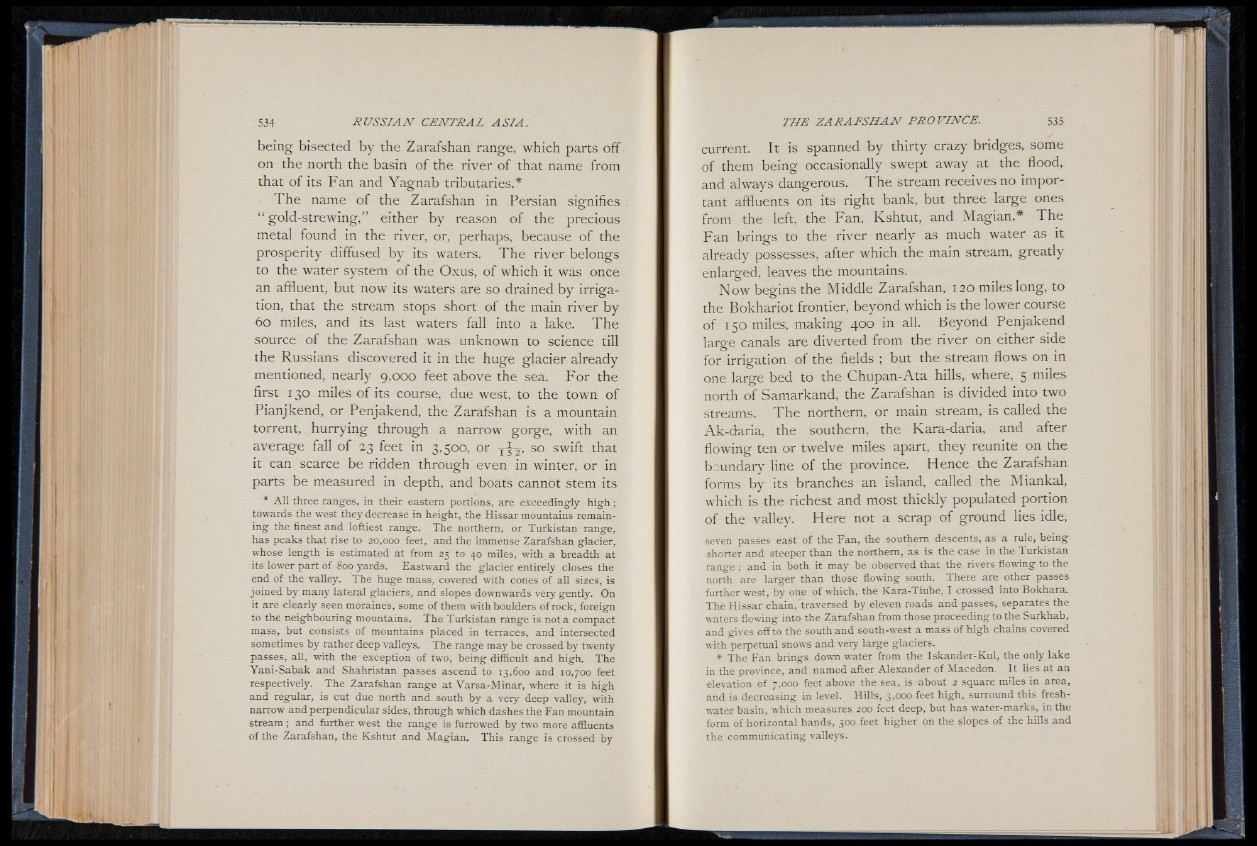
being bisected by the Zarafshan range, which parts off
on the north the basin of the. river of that name from
that of its Fan and Yagnab tributaries.*
The name of the Zarafshan in Persian signifies
“ gold-strewing,” either by reason of the precious
metal found in the river, or, perhaps, because of the
prosperity diffused by its waters. The river belongs
to the water system of the Oxus, of which it was once
an affluent, but now its waters are so drained by irrigation,
that the stream stops short of the main river by
60 miles, and its last waters fall into a lake. The
source of the Zarafshan was unknown to science till
the Russians discovered it in the huge glacier already
mentioned, nearly 9,000 feet above the sea. For the
first 130 miles of its course, due west, to the town of
Pianjkend, or Penjakend, the Zarafshan is a mountain
torrent, hurrying through a narrow gorge, with an
average fall o f 23 feet in 3,500, or y^-, so swift that
it can scarce be ridden through even in winter, or in
parts be measured in depth, and boats cannot stem its
* A ll three ranges, in their eastern portions, are exceedingly h ig h ;
towards the west they decrease in height, the Hissar mountains remain-
in g the finest and loftiest range. The northern, or Turkistan range,
has peaks that rise to 20,000 feet, and the immense Zarafshan glacier,
whose length is estimated at from 25 to 40 miles, with a breadth at
its lower part of 800 yards. Eastward the glacier entirely closes the
end of the valley. The huge mass, covered with cones of all sizes, is
joined by many lateral glaciers, and slopes downwards very gently. On
it are clearly seen moraines, some of them with boulders of rock, foreign
to the neighbouring mountains. The Turkistan range is not a compact
mass, but consists of mountains placed in terraces, and intersected
sometimes by rather deep valleys. The range may be crossed by twenty
passes, all, with the exception of two, being difficult and high. The
Yani-Sabak and Shahristan passes ascend to 13,600 and 10,700 feet
respectively. The Zarafshan range at Varsa-Minar, where it is high
and regular, is cut due north and south by a very deep valley, with
narrow and perpendicular sides, through which dashes the Fan mountain
stream ; and further west the range is furrowed by two more affluents
of the Zarafshan, the Kshtut and Magian. This range is crossed by
current. It is spanned by thirty crazy bridges, some
of them being occasionally swept away at the flood,
and always dangerous. The stream receives no important
affluents on its right bank, but three large ones
from the left, the Fan, Kshtut, and Magian.* The
Fan brings to the river nearly as much water as it
already possesses, after which the main stream, greatly
enlarged, leaves the mountains.
Now begins the Middle Zarafshan, 120 miles long, to
the Bokhariot frontier, beyond which is the lower course
of 150 miles, making 400 in all. Beyond Penjakend
large canals are diverted from the river on either side
for irrigation of the fields ; but the stream flows on in
one large bed to the Chupan-Ata hills, where, 5 miles
north of Samarkand, the Zarafshan is divided into two
streams. The northern, or main stream, is called the
Ak-daria, the southern, the Kara-daria, and after
flowing ten or twelve miles apart, they reunite on the
boundary line of the province. Hence the Zarafshan
forms by its branches an island, called the Miankal,
which is the richest and most thickly populated portion
of the valley. Here not a scrap of ground lies idle,
seven passes east of the Fan, the southern descents, as a rule, being
shorter and steeper than the northern, as is the case in the Turkistan
range ; and in both it may be observed that the rivers flowing to the
north are larger than those flowing south. There are other passes
further west, by one of which, the Kara-Tiube, I crossed into Bokhara,
The Hissar chain, traversed by eleven roads and passes, separates the
waters flowing into the Zarafshan from those proceeding to the Surkhab,
and gives off to the south and south-west a mass of high chains covered
with perpetual snows and very large glaciers.
* The Fan brings down water from the Iskander-Kul, the only lake
in the province, and named after Alexander of Macedon. It lies at an
elevation of 7,000 feet above the sea, is -about 2 square miles in area,
and is decreasing in level. Hills, 3,000 feet high, surround this freshwater
basin, which measures 200 feet deep, but has water-marks, in the
form of horizontal bands, 300 feet higher on the slopes of the hills and
the communicating valleys.